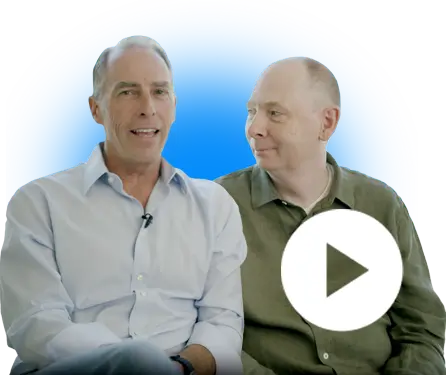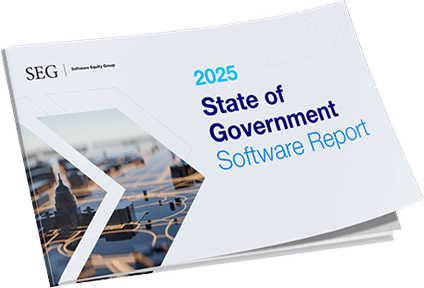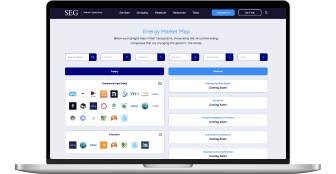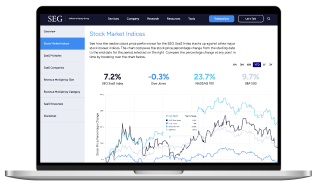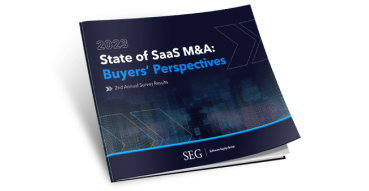See our expert take on Education software—industry challenges and opportunities, where M&A activity stands, along with insights to help you start thinking about key strategic decisions for growth or going to market. Presented by Paul Lachance, SEG’s Chief Industry Strategist, this comprehensive overview will help you navigate the ever-evolving Education software landscape.
TRANSCRIPTION
Introduction
{Paul Lachance:} Hi everybody. Paul Lachance here. I’m going to do a preview of our state of education software report. We’ll cover the current state of the education sector, including headwinds and tailwinds. We’ll get into the SaaS software landscape and mergers and acquisitions, observations, and market drivers.
Education Headwinds, Tailwinds, & Market Drivers
{Paul Lachance:} Some headwinds for the industry might be tailwinds for the technology companies that create it. Let’s run through it from a headwind standpoint. We break this out by K-12 and higher education. Sometimes they cross over significantly, other times not.
One major headwind is funding cliffs. This is a common concern. Schools that used ESSER funding during COVID were able to purchase technology to support their school districts, especially with remote learning. Those funds are drying up and will be gone by September 2024. Many schools that used CapEx funds for what would normally be an operational budget to purchase SaaS software will face challenges in renewing subscriptions. This is generating a lot of news in the sector.
Other headwinds include teacher burnout, shortages, and retirements. Teachers and staff have been through a lot in this industry and need tools to help with their heavy workloads. The gap in achievements, grades, and other metrics has widened, especially since COVID.
On the tailwind side, technological advancements are giving schools opportunities to combat these headwinds. There is a focus on social-emotional learning, considering the whole student and various other aspects, which we’ll cover in this report.
Higher education also faces several headwinds, such as demographic shifts and the different types of learners entering educational institutions. Costs are rising. Higher education costs are increasing at a rate much faster than normal CPI and inflation, and this is considered one of the more challenging expenses in the US right now. There are tools and methods to battle these costs without sacrificing the student experience, and a variety of other headwinds are covered in the report.
Tailwinds include closing the skills gap and workforce development. Many educational opportunities are appearing for non-traditional college and university students, professional certificates, advanced manufacturing-type learning, and more. Technological innovation in this sector is amazing, and there are opportunities for more globalization, where students from anywhere can participate in massive online classes and partnerships with government and industry.
There’s a variety of other tailwinds covered in the report from a macroeconomic perspective. There are some challenging aspects of our society and economy right now, including inflation. While it’s down from a high of 9.1% in 2022 to below 3%, it’s still expensive to operate in today’s business climate. Energy remains a high-cost part of all school budgets. It’s come down from the highs but is still costly.
Labor is also a huge challenge. The Great Resignation during the pandemic became the Great Reshuffle. It has settled down somewhat, but with the massive exit of retiring baby boomers, especially in operational jobs in the education industry, there is still a burden. We will cover some of these examples in the report.
Finally, there’s the supply chain, whether you’re ordering books or spare parts to keep your campus running. We’ve been through a lot with the supply chain. Normal disruptions, like the Baltimore Bridge collapse or recent railway challenges in Canada, would normally cause major ripples.
We have trade disputes, US-China tariffs, and a financial crisis that we are still recovering from. There are two global military conflicts, and we are recently out of an extreme pandemic. These disruptions rank alongside supervolcanoes, meteor strikes, and solar storms in terms of their impact on our supply chain, which affects all aspects of society, including educational institutions.
Sector Overview
{Paul Lachance:} So let’s break down the state of education by sector. We categorize it by K-12 and higher education. Both sectors are huge and represent many different kinds of schools, from traditional brick-and-mortar schools to homeschooling and online schools. There are a lot of students, school districts, and teachers. We spend a significant amount of money as a country.
We’re approaching a trillion dollars in expenditures in K-12. It costs $17,000 per student on average to educate. The market size is huge. Some argue we could save money here. I believe we can, but without sacrificing student and staff outcomes.
From a higher education standpoint, we break it down into various types of colleges. There are many, and it’s a much larger technology market than K-12, with expected growth.
Learn More: Visit our Education Software Sector Page for an overview of the space.
Digital Transformation
{Paul Lachance:} Digital transformation is a key concept. Although it involves digital tools, it’s not solely about technology; it’s about viewing challenges and opportunities differently. It’s about shifting the mindset to identify challenges and opportunities that our educational institutions face.
Once identified, technology can provide solutions. For example, if there aren’t enough people to do the work in a school, can technology ease that burden? That’s the digital transformation mindset, and that’s what SaaS software can help with. It focuses on positive student and staff outcomes, emphasizing efficiency, better asset management, and budget adherence. Many challenges and opportunities need digital transformation, and these are just a few examples.
Deferred maintenance is a prime example. In the past, there was a mindset of just building a new school, but that’s no longer feasible. We don’t have the real estate or funding. We must be more proactive about maintenance to ensure our schools are resilient and provide a better learning environment.
Mass retirements and skill shortages mean there aren’t enough people to get the work done. Opportunities like using the internet, mobile devices, augmented reality, and virtual reality to enhance learning are vast.
Key elements of digital transformation include a holistic approach involving the entire organization. Technology is amazing, but it doesn’t work well when someone in an office decides to implement it across the school. The entire organization and all stakeholders who will use and benefit from these technologies must be involved to ensure proper implementation and adoption.
Industry 4.0 technologies—like artificial intelligence, machine learning, the Internet of Things, and cybersecurity—are driving digital transformation and helping with data-driven decision-making, making smarter decisions with all the data we have in our schools.
The Intersection of the Physical and Digital Worlds
{Paul Lachance:} SaaS software is increasingly relying on the intersection of physical and digital worlds, especially artificial intelligence and the Internet of Things. We’re connecting to our facilities, assets, vehicles, and people. Indoor air quality is a high-level example. Readily available sensors can be installed in classrooms or offices to monitor volatile organic compounds, CO2 levels, airflow, and temperature. Studies have shown poor air quality negatively impacts student outcomes.
Monitoring these factors and addressing problems can all be managed through sensors and SaaS software. The same goes for energy usage. Sensors and energy management platforms can help optimize how energy is used, a significant expense for schools.
Another example is bus routing. Communication optimization centers and buses equipped with location technology can properly route buses. A message from your app that says a student is sick could reroute the bus to save fuel and time, all of which add up. Optimized bus routes save fuel. These are just a few examples, along with general sensor IoT deployment.
Pushing Up the P-F Curve for Asset/Facility Optimization
{Paul Lachance:} I’ll run through an example called the P-F curve. The P-F curve shows that when you have a school facility with assets like HVAC units, those assets require maintenance. When an asset is installed, it’s in the best condition it will ever be. Over time, performance declines until it hits the “P” point in the P-F curve, where failure can be detected. You can’t see, smell, or hear the issue with human senses, but if ignored, it will degrade to the point of functional failure. This is when the asset can no longer perform as intended, and quality drops.
Ignoring these problems leads to catastrophic failure, unplanned downtime, and replacement of the asset. Maintenance and operations professionals aim to push up the P-F curve. Preventive maintenance, like checking an HVAC unit monthly or changing the filter, can help. Better yet, sensors in the assets can tell you when a filter is 75% clogged and needs replacing. Catching problems early minimizes downtime, keeps assets running well, and saves a lot of money.
Early intervention on the P-F curve saves significant costs compared to neglect. SaaS software, enterprise asset management, and CMMS software, aided by sensors, can drive this effort. This can save both operational budgets and capital expenditures. If an HVAC unit is ignored until it fails, replacing it prematurely is much more expensive than addressing problems early. SaaS software, especially when interfacing between the digital and physical worlds with sensors, AI, and machine learning, can help achieve this.
Education SaaS Innovations
{Paul Lachance:} There are many other innovations we’re seeing in SaaS/software in the education sector, like workflow communication and collaboration. This is permeating all traditional types of software—SIS, LMS, EAM, and more—making these tools smarter.
Workflow automation allows software to perform tasks automatically based on conditions or actions, making it adaptable to your processes rather than forcing you to adapt to rigid software structures.
Automatic notifications between parents, teachers, staff, bus drivers, and maintenance personnel help speed up communication and foster collaboration.
Students and teachers working together through online learning platforms are just one example of this innovation in SaaS software, making these products smarter and more efficient.
We’re also seeing these tools adapt to today’s learners, who have always had challenges, but we’re no longer just putting everyone in the same box. Social Emotional Learning (SEL) is a good example. It engages all types of learners and helps educational institutions find students where they are, taking into account mental health and other factors. While these aren’t necessarily technology-based, they enable schools to look at students individually, which has always been challenging because personalized learning at scale in schools was previously impossible.
But personalized learning, embedded into educational software platforms, is making a real difference. For example, in a classroom, a student with dyslexia may struggle to keep up, while another is bored because they already know the material. AI-powered personalized learning platforms can tailor the experience to different kinds of learners. These technologies help teachers provide a more personalized approach, improving student engagement and motivation, which leads to better learning outcomes. These are powerful innovations across all software platforms.
Gamification is another innovation, especially for younger learners. For example, even apps for nutrition and exercise use gamification to make learning more fun. Anything that makes educational lessons more engaging and fun while still effective is finding its way into SaaS software learning platforms.
Market Maps
{Paul Lachance:} So, let’s look at the SaaS landscape. We break it down by K-12 and Higher Education. For K-12, we categorize it into administration, student-teacher, staff, and operations. There are many sub-genres of SaaS software within each category, which vary across different types of schools.
The full report goes into much more detail and breaks these down further. The market map shows a wide range of categories and many software companies supporting different types of software. The report and our website provide more details on these companies and sub-genres.
Learn More: View key players in our K-12 or Higher Education software vendor landscape. Visit the page to submit a request to be featured in our market maps.
For higher education, the landscape is even bigger. There are enrollment operations, administration, advancement, fundraising, student-teacher staff, and continuing education and professional development. These vary based on the type of institution. The market map is extensive, and there is crossover between K-12 and higher education. The full report offers more detailed information. Download the full State of Education Software report.
M&A Deal Activity
{Paul Lachance:} Finally, let’s discuss M&A observations. There’s a lot of excitement in this sector. The education software sector is seeing significant trends, including personalized solutions for diverse academic needs, operational improvements for better infrastructure, administrative solutions for data analysis, and communication platforms for compliance. Private equity and strategic investors are recognizing these opportunities.
Private equity, in particular, has become a major player in this sector, with over 60% of the deals. The full report provides more detail on M&A activity.
Software Equity Group knows these sectors well. We help our clients find their next investor. I invite you to get acquainted with Software Equity Group and learn more from us. This is just a teaser for the full report. I hope you find it informative. For more information, please download the full report or reach out. Thank you very much, and have an awesome day.
